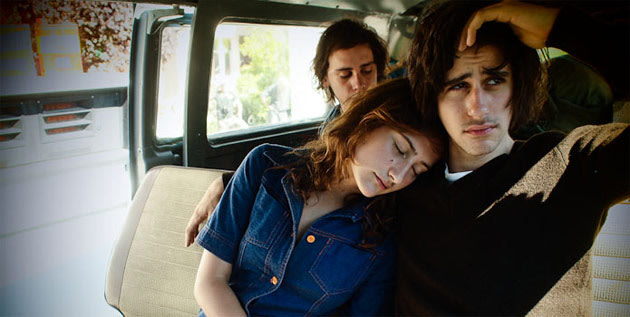Director: Olivier Assayas
Runtime: 122 minutes
"You always watch, but never act," says a young student revolutionary to fellow student Gilles (Clement Metayer). It's a simple, pointed statement, yet the way it echoes across Something in the Air, the latest film by Olivier Assayas (Summer Hours, Carlos) is surprisingly rich. Assayas' new work is not as immediately intimate as Summer Hours nor as epic and intense as Carlos. Instead, it rests in a comfortable middle ground, all while weaving a compellingly crafted, albeit somewhat meandering, tale of self discovery.
Set against the social upheavals of the 1960s, Assayas turns his focus from middle-aged siblings and international terrorists to high school students on the cusp of pseudo-adulthood. In the opening, we're introduced to Metayer's Gilles, as he draws the anarchy symbol in a notebook while his teacher drones through a lecture. Immediately following this simple prologue comes the film's highlight, a stunning riot-turned-chase sequence that showcases Assayas at his best. It's a frank, invigorating piece of directing that, like much of film, boasts some stellar muted visuals and roving camera work.
After the jolt of an opening, the film ebbs and flows through scenes of high and low tension. Gilles' girlfriend Laure (Carole Combes) leaves for the summer. Feeling somewhat aimless, Gilles falls further into the ranks of various anarchist, communist, and socialist groups, dominated particularly by high school and collegiate members. Along with his friends Christine (Lola Creton) and Alain (Felix Armand), Gilles spends his summer traveling across Southern Europe. His journeys take him to Italy, where he meets up with a group of American flower children, including aspiring dancer Leslie (India Menuez). Gilles explores his passion for painting and film, Alain takes up with Leslie, and Christine finds herself working with a group of underground Italian filmmakers.
For the first half of the two hour runtime, Assayas' writing and directing, along with the technical aspects, help create an excellent, immersive experience. There's nothing quite as intense as the riot scene (save for another early fight/chase sequence), but Assayas captures the atmosphere of the film's world with excellent grace. Gilles and company are protagonists, but Assayas is not necessarily out to lionize everything they say or do. He does not glorify the flower child/hippie aesthetic, even as he allows it to inform the film's themes and character arcs. The camera, often moving in, out, and around particular spaces, maintains a rather objective view that keeps the deeper emotions at a distance, but never out of reach. The one distracting aspect of the camera work and editing is that Assayas inserts a number of jarring fades to black, some of which come right as a character finishes speaking. For a film with such fluid visual movement, these sudden interludes come as a rude and unpleasant disruption.
Only in the second half do Assayas' ambitions start to get the better of him. Somewhere in hour two, the narrative sends Gilles, Alain, and Christine apart from each other, which makes certain stretches meander to the point that the feel like they might run out of steam. The character of Leslie, somewhat stiffly acted by Menuez, is intriguing as the lone significant American presence, yet remove her arc (which involves a trip to Kabul, an abortion, and a return to the United States), and you don't lose much. Similarly distracting on his own is Alain, who eventually acts more as a channel for information. At its heart, this is Gilles' story. As such, the supporting characters who matter most are those he is most intimate with: Christine and Laure. These connections allow the film to break out of its detached shell, without ever going near melodramatic territory.
Gilles' journey, despite all of the traveling, is largely internal. And, despite his relatively static expression, young Mr. Metayer (who looks like a hybrid of Ben Whishaw and Gael Garcia Bernal) carries the role in such a manner that the performance has subtlety, rather than emptiness. No individual performer makes a mark as well as Assayas' direction, but the roles are - some of Menuez's scenes excepted - carried off with a low key effortlessness.
Yet by the time Assayas reaches his conclusion, it's hard to find much more than the surface of Gilles' journey. As Gilles becomes more of the central focus, Something in the Air regains the sense of purpose of its first hour, and builds on that momentum. Yet the developments feel limited more to the physical. Because Gilles' changes are never large, and are mostly internalized, the ending is left flapping its arms aimlessly to stay afloat for some hazy, aloof purpose. As a work of craftsmanship and atmosphere, Something in the Air represents a big step up for Assayas after the irritating and draggy Summer Hours, but its thematic and character-oriented developments leave one with little to mull over other than the surface.
Grade: B+

No comments:
Post a Comment